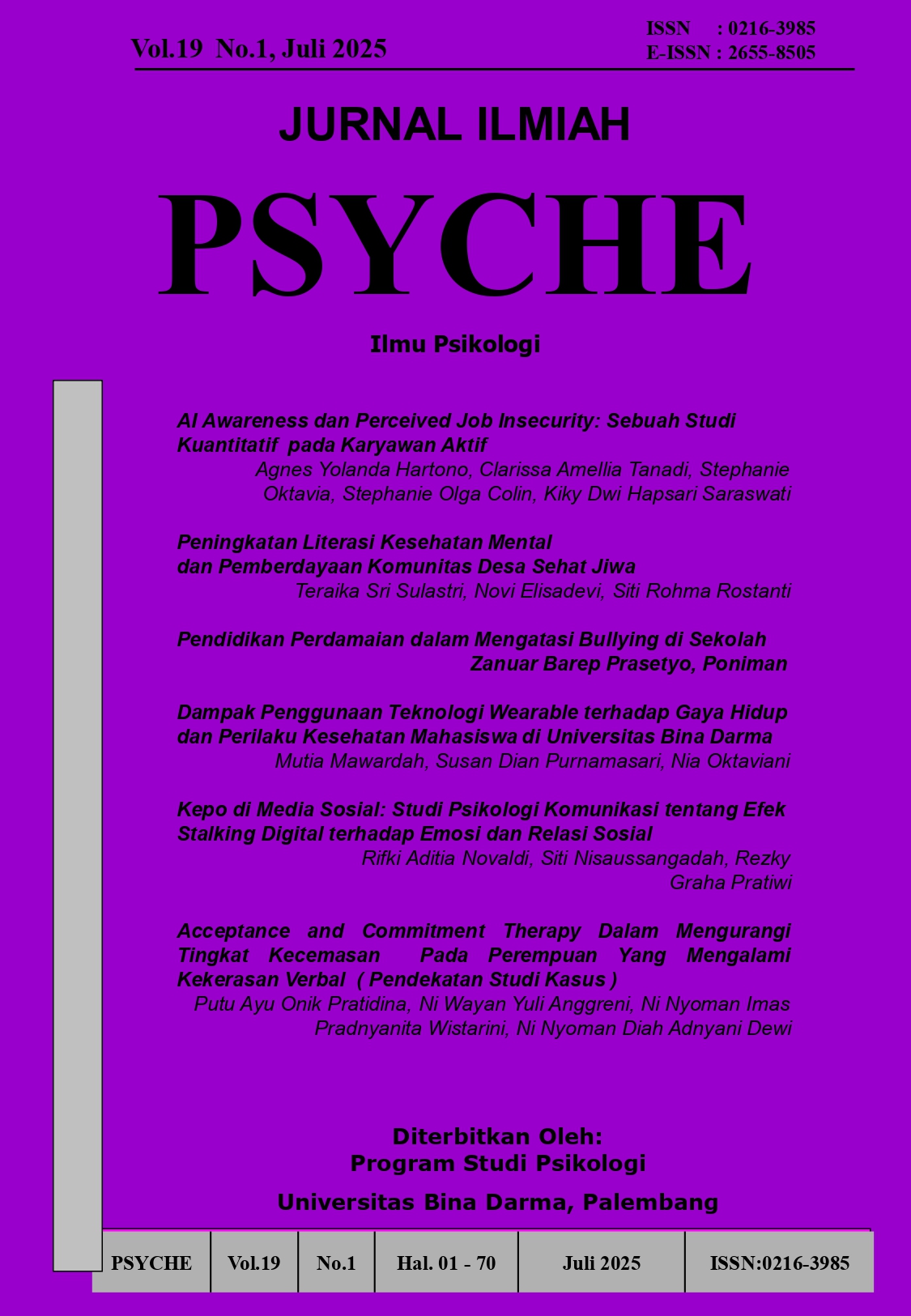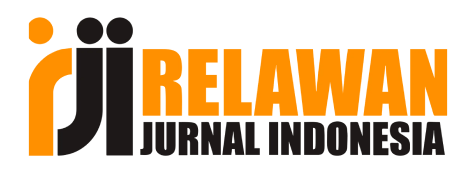AI Awareness dan Perceived Job Insecurity: Sebuah Studi Kuantitatif pada Karyawan Aktif
DOI:
https://doi.org/10.33557/gghfc152Keywords:
Artificial Intelligence, Job Insecurity, AI Awareness, EmployeeAbstract
The advancement of artificial intelligence (AI) technology has significantly transformed organizational structures and work dynamics, introducing new challenges for employees in adapting to digital transformation. AI is increasingly integrated into various workplace systems and is influencing the role of human labor in organizations. This study aims to examine the relationship between AI awareness and perceived job insecurity among active employees from various professional fields. Using a quantitative approach with a correlational design, data were collected from 130 participants through an online questionnaire that included validated scales measuring AI Awareness and Job Insecurity. Normality tests showed that the data were not normally distributed; therefore, the hypothesis was tested using Spearman’s correlation analysis. The results revealed a strong and significant positive relationship between AI awareness and perceived job insecurity (r = 0.714, p < 0.001). These findings suggest that higher awareness of AI’s roles and impacts is associated with a greater sense of job insecurity, both in quantitative and qualitative aspects. Theoretically, this research contributes to the growing body of knowledge on the psychological effects of technological developments. Practically, the findings highlight the importance of implementing more human-centered change management strategies, including transparent communication and psychological support for employees. The study’s limitations include the use of non-probability sampling and a relatively small sample size, which restrict generalizability. Future research is recommended to broaden the sample scope across work sectors and to explore potential mediating or moderating variables in the relationship between AI awareness and job insecurity.
References
Brynjolfsson, E., & McAfee, A. (2014). The Second Machine Age: Work, Progress, and Prosperity in a Time of Brilliant Technologies. W. W. Norton & Company.
Chirumbolo, A., & Hellgren, J. (2003). Individual and organizational consequences of job insecurity: A European study. Economic and Industrial Democracy, 24(2), 217-240. doi:10.1177/0143831x03024002004
Davenport, T. H., & Ronanki, R. (2018). Artificial intelligence for the real world. Harvard Business Review, 96(1), 108–116.
De Witte, H. (2005). Job insecurity: Review of the international literature on definitions, prevalence, antecedents and consequences. SA Journal of Industrial Psychology, 31(4), 1-6. doi:10.4102/sajip.v31i4.200
De Witte, H., De Cuyper, N., Handaja, Y., Sverke, M., Näswall, K., & Hellgren, J. (2010). Associations between quantitative and qualitative job insecurity and well-being. International Studies of Management & Organization, 40(1), 40-56. doi:10.2753/imo0020-8825400103
Fischmann, G., De Witte, H., Sulea, C., Elst, T. V., De Cuyper, N., & Iliescu, D. (2022). Validation of a short and generic qualitative job insecurity scale (QUAL-JIS). European Journal of Psychological Assessment, 38(5), 397-411. doi:10.1027/1015-5759/a000674
Frey, C. B., & Osborne, M. A. (2017). The future of employment: How susceptible are jobs to computerization? Technological Forecasting and Social Change, 114, 254–280.
Gomes, A. F., Veloso, A., & Costa, P. (2024). Psychometric analysis and validation of the job insecurity scale in universities. Psicologia: Teoria e Pesquisa, 40. doi:10.1590/0102.3772e40509.en
Hassan, A. H., Baquero, A., Salama, W. M., & Khairy, H. A. (2024). Engaging hotel employees in the era of artificial intelligence: The interplay of artificial intelligence awareness, job insecurity, and technical self-efficacy. Journal of Logistics, Informatics and Service Science, 11(5), 522-539. doi:10.33168/jliss.2024.0530
Helen, H., Alfyoni, G. A., Christianto, A. B., Jess, S., & Saraswati, K. D. H. (2024). RAISA: Threat or opportunity for careers? A study on internship students in Jabodetabek. Psikostudia: Jurnal Psikologi, 13(3), 388. doi:10.30872/psikostudia.v13i3.15299
Hwang, J., Lee, Y., & Kwon, O. (2023). Employees’ technology readiness and its impact on job insecurity during digital transformation. Technological Forecasting and Social Change, 191, 122485. doi:10.1016/j.techfore.2023.122485
Jarrahi, M. H. (2018). Artificial intelligence and the future of work: Human-AI symbiosis in organizational decision making. Business Horizons, 61(4), 577–586.
Liu, R., & Zhan, Y. (2020). The impact of artificial intelligence on job insecurity: A moderating role based on vocational learning capabilities. Journal of Physics: Conference Series, 1629(1), 012034. doi:10.1088/1742-6596/1629/1/012034
Lwanga, S. K., & Lemeshow, S. (1991). Sample size determination in health studies: A practical manual. Geneva: World Health Organization.
Meijerink, J., Bos-Nehles, A., & de Leede, J. (2022). Understanding the influence of AI on employees' job insecurity and work engagement. Journal of Business Research, 149, 584–595. doi:10.1016/j.jbusres.2022.05.024
Nawrocka, S., De Witte, H., Pasini, M., & Brondino, M. (2023). A person-centered approach to job insecurity: Is there a reciprocal relationship between the quantitative and qualitative dimensions of job insecurity? International Journal of Environmental Research and Public Health, 20(7), 5280. doi:10.3390/ijerph20075280
Sumantri, O. R., Violi, L., Anastasia, V., Annissatya, K. A., & Saraswati, K. D. H. (2024). AI opportunity perception and workplace wellbeing: A study on student interns in the era of smart technology. Psikostudia: Jurnal Psikologi, 13(3), 464. doi:10.30872/psikostudia.v13i3.15959
Susskind, R., & Susskind, D. (2015). The Future of the Professions: How Technology Will Transform the Work of Human Experts. Oxford University Press.
Sverke, M., Hellgren, J., & Näswall, K. (2002). No security: A meta-analysis and review of job insecurity and its consequences. Journal of Occupational Health Psychology, 7(3), 242-264. doi:10.1037//1076-8998.7.3.242
Vander Elst, T., De Witte, H., & De Cuyper, N. (2014). The job insecurity scale: A psychometric evaluation across five European countries. European Journal of Work and Organizational Psychology, 23(3), 364-380. doi:10.1080/1359432x.2012.745989
Vieira dos Santos, J., Gonçalves, S. P., Silva, I. S., Veloso, A., Moura, R., & Brandão, C. (2022). Organizational and job resources on employees’ job insecurity during the first wave of COVID-19: The mediating effect of work engagement. Frontiers in Psychology, 12. doi:10.3389/fpsyg.2021.733050
Zhao, H., Ye, L., Guo, M., & Deng, Y. (2025). Reflection or dependence: How AI awareness affects employees’ in-role and extra-role performance? Behavioral Sciences, 15(2), 128. doi:10.3390/bs
Downloads
Published
Issue
Section
License

Jurnal Ilmiah Psyche by http://journal.binadarma.ac.id/index.php/jurnalpsyche is licensed under a Creative Commons Attribution-ShareAlike 4.0 International License.









